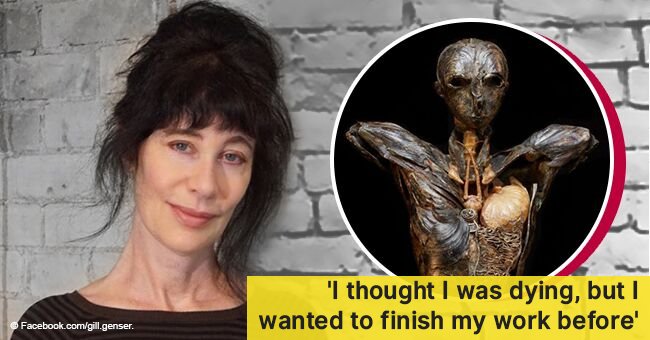
Woman worked on a sculpture for 15 years without knowing it was killing her
After working on a sculpture for fifteen years, an artist found out her work was poisoning her. However, she said that she does not hold any grudge against what made her ill, but what happened taught her a great lesson about our world.
Gillian Genser, 59, has worked as a sculptor since 1991, in Toronto, Canada.
At first, the woman did sculptress with natural materials, including eggshells, animal bones, corals and even dried plants.
In 1998, she finished the sculpture "Lilith," the first woman in Jewish folklore, made of eggshells. Then, she decided that her next project would go further, so she started working on the first man, Adam, but this time with another material: mussel shells.
These shells came from the Atlantic coast of Canada and Genser bought them in bulk at Chinatown in Toronto so she could dig through the shells with ease and choose the ones that had the shapes she needed.
“The work was an environmental statement. It’s about reconsidering what people’s first perception of the ecosystem should have been, rather than this idea that we have dominion over all the animals,” she told the Washington Post.
THE FIRST SYMPTOMS
After cooking the mussels to her friends, two or three times a week, she then sat down to work with the shells, spending up to 12 hours a day cleaning and sanding them with a dentist's drill until she got the shape she was looking for to recreate Adam's muscles.
A few days after she started her work, the symptoms began to appear. First, came the headaches and vomiting, but since Genser had battled a series of autoimmune disorders all of her life, she thought nothing of it.
However, things took a turn for the worse: she felt constantly agitated and would wake up to find out she could hardly move. Then she started to lose hearing on her left ear; her muscles became stiff and her speech slurred.
Concerned, Genser visited a long list of specialists, but neither neurologists nor rheumatologists nor endocrinologists were able to give her a definitive diagnosis.
And when the doctors asked her if she worked with any toxic material, she said no, stating that she only used natural objects.
“The symptoms worsened […] I became combative and fatalistic, declaring that my life was over. My husband was afraid to leave the house, worried he’d come home and find me hanging from the chandelier. He found friends to babysit me. These symptoms continued, on and off, for 15 years.”
One day in 2013, Genser was cleaning her ventilation, which had years of fine dust accumulated, when she started to feel weak. She was bed-ridden for a week, feeling completely disoriented, and her short-term memory was affected, to the point of forgetting the names of her friends.
The psychiatrists joined the list of specialists she visited, but the prescribed antipsychotics and antidepressants did not help her at all.
Genser was convinced she was dying and was determined to finish Adam, not knowing that the sculpture was slowly killing her.
It was in 2015 when a specialist performed a blood test and discovered that she had very high levels of arsenic and lead in her blood. “I was flabbergasted. Absolutely flabbergasted," confessed Genser.
THE IRONY IN HER POISONING CASE
The sculptor consulted a professor specializing in invertebrates at the Royal Museum of Ontario, who was horrified to learn that Genser had worked with the mussels for so many years. "He told me, ‘People don’t realize how poisonous these things are,’” she said.
Mussels accumulate toxins such as arsenic and lead in their years of living in polluted waters. By touching the shells and breathing the resulting dust of her work, part of the metal entered his body, starting a slow and painful poisoning process to her nervous system.
Genser finished the sculpture, but now describes her quality of life as “poor.”
“I completed Adam in 2015. If I had left him unfinished, this all would have been for nothing,” she wrote on an essay for the Toronto Life magazine.
“When I look at Adam, I feel grief—both for myself and our planet. But I also feel satisfaction because he is magnificent. That’s how I find my hope. I call him my beautiful death.”
For her, the poisoning she has suffered is deeply ironic, considering that her initial purpose using shells was to represent the distorted relationship of humanity with the now contaminated natural world.
“I’ve experienced the suffering of so many creatures trapped in their polluted habitats. I now hope their voices can be heard—that my art might create a sense of awe, a sense of connectivity and reverence for the natural world,” she reflected.
And even if she no longer works with the shells, Genser’s health did not fully recover. She still suffers from nausea and has memory problems; she’s also propense to suffer from Parkinson or Alzheimer.
But still, the artist does not hold a grudge against the sea creatures that destroyed her body. “I feel terrible grief for them. We did this to them; they didn’t do it to me,” she concluded.
ENVIRONMENTAL ALARM
The contamination of our nature is a subject that can not be overlooked. Thousands of animals die every year due to human unconsciousness, and even our specie is in danger due to the lack of care we have for Mother Nature.
In an alarming example, the Clarín web portal published a gallery of images in which a group of fishermen found a dead whale on the shore of the island of Sulawesi, Indonesia, and when they opened her stomach, they found 15 plastic cups, four glass bottles, and 25 plastic bags.
The material found in the animal's body weighed more than six kilos.
Rescuers from the Wakatobi National Park told the media that they still don’t know if the content in the mammal's stomach caused her death. However, they want people to keep raising awareness to protect our environment actively before it’s too late.
